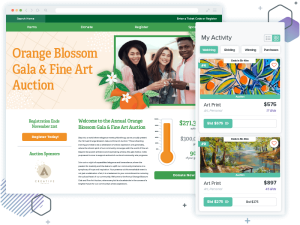For every 1,000 donation request emails sent in 2024, nonprofits raised $58, which is a 10% decrease from 2023. While emails are a cost-effective, efficient way to solicit contributions, organizations need to put more effort into their email fundraising strategies to see the results they seek.
In this guide, we’ll provide tips to help you develop more effective donation request emails and provide some examples to jumpstart your strategy:
7 tips to better ask for donations via email

1. Time your emails strategically.
Timing affects email open and click-through rates, which lead to donation conversions. If you send your emails at the right time, you can catch your donors when they’re most receptive to giving and increase the effectiveness of your email appeals.
Best days to send donation emails
You should send most of your donation emails on weekdays, as many people check their inboxes throughout the work day. In particular, emails sent mid-week (Tuesday, Wednesday, and Thursday) often perform best.
While the weekend often has lower engagement rates, depending on your specific donor base, it can still be an effective time to send an email.
Best times to send donation emails
- Early morning: 7 a.m. – 10 a.m.
Sending emails early in the morning allows people to see your donation appeal before heading to work for the day. - Late morning: 10 a.m. – 1 p.m.
Late morning is another effective time to send email appeals. - Early afternoon: 1 p.m. – 4 p.m.
Because people check their emails after lunch, early afternoon is another good time to send your email donation appeals. - Early evening: 4 p.m. – 7 p.m.
The early evening is often the last time of day people check their emails before winding down for the night.
While general days and times can provide a good starting point, it’s important to tailor your email send times to your specific audience.
2. Create eye-catching subject lines.
Most people receive a multitude of emails every day—the average office worker receives about 121 emails per day! Some are important and stored in their inboxes, while others are glanced over and deleted. Still others are marked as spam and go to the trash folder, never to see the light of day again.
Where are your nonprofit’s emails going?
While you can’t physically prevent your email recipients from moving your fundraising emails to their trash folders, you can decrease the chances that they’ll do so with an eye-catching subject line.
Instead of vague, boring phrases that don’t explain what the email is about, be direct with your email recipients. If you want them to donate, tell them so.
An example of a not-so-great email subject line would be:
“Do you like puppies?”
This sentence doesn’t communicate anything to the reader and says nothing about your organization or why you’re emailing them.
Instead, try something along the lines of:
“Donate now to help Sprinkles the puppy find a home.”
This subject line tells the recipient exactly what you’re asking of them and explains where the money will go. You can also include the nonprofit’s name as an additional detail, but just make sure your subject line doesn’t get too long!
While you should be sending more than just donation request emails to your donors, pay attention to your subject lines when the time comes to make an ask. If you don’t put thought into them, your recipients won’t feel compelled to open your emails.
Likewise, if you’re sending a stewardship email, make it clear in the subject line! If recent donors see an email from your nonprofit, you don’t want them to assume you’re already asking for another gift. Leave no doubt! If you’d like some guidance in creating your subject line, explore free subject line analyzers online, including the Email Line Subject Line Tester from CoSchedule.
3. Don’t wait to ask.
When making in-person appeals, slow and steady wins the race. But when you ask for donations via a fundraising email, you should get straight to the point.
Make your ask within the first two paragraphs—the earlier, the better!
You don’t want recipients to read your email and wonder what the point is. If you beat around the bush and don’t get to the ask until the last paragraph, many readers will have already tuned you out and moved on to the next message in their inbox.
Make sure that your appeal is easy to see. Make it bold. Make the font larger. Keep the email aesthetically appealing, but make a point to highlight the ask itself.
By heeding this advice, your nonprofit can incorporate email appeals into your larger fundraising strategy!
4. Explain and describe your nonprofit’s background.
For those who are new to your organization, you’ll need to include more information about:
- The work that you do
- Who you serve
- What specific projects, programs, or initiatives their donations will support
- Any other relevant insights
Keep in mind that, at its core, your appeal email is an appeal. Any extra information should serve as support for that purpose. In your email, you can even include information about what specific donation amounts will fund, like the example below:
Keep in mind that, at its core, your donation request email is an appeal. Any extra information should support that purpose. You can even include information about what specific donation amounts will fund.
For instance, include information about the new project your organization is attempting to complete, but add that you still need “$X” to bring it to fruition.
Donors don’t need a full background history of your nonprofit at this moment, but they do need you to paint a clear picture of how they can help through concise storytelling. Get to the point and include information that encourages recipients to give to your cause.
5. Keep it personalized.
It can be easy to slip into blanket statements and generalities whenever you ask for donations via email.
However, it’s crucial to remember that your donors are all individuals and should be treated as such.
One way you can personalize your email communications to donors is to use donor data to segment your email lists. For instance, a donor who has given to your organization repeatedly over months and years should receive a different email than someone who has just started volunteering with you. Additionally, segmenting inactive donors can help nonprofits maintain high open rates. Your segmented lists might include groups based on the following criteria:
- Recurring donors
- Volunteers
- One-time donors
- Lapsed donors
- Major donors
- Preferred communication channels
- Donor interests
- Demographics
By segmenting your email recipients into different demographics, you can better personalize your correspondence and increase the chances that individuals will click through to donate. Segmenting your email lists by topic allows your organization to target donors with relevant interests, just as the example image below segments visitors based on the article topic they’re interested in:
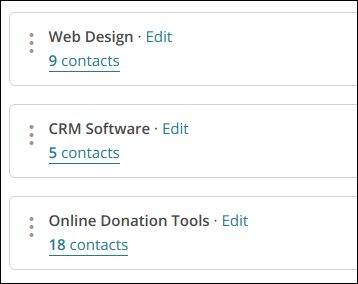
6. Make it easy to give.
If you provide your donors with the means to donate within the body of the email, they will be more motivated to do so. Depending on how your email is structured, this could take a variety of forms:
- A link anchored in the body of the email that leads recipients to the donation form on your website.
- A “Donate Now” button placed somewhere highly visible within the body.
- A link to your Facebook page’s donation form (if applicable).
- An address where they can send a check.
- A number they can call to donate over the phone.
Additionally, you can provide links for donors who are looking for other routes to give by directing them to your “Ways to Give” page or to more general information about donating.
The more ways you have for donors to give, the better off you’ll be. However, avoid including too many competing calls to action so as not to overwhelm them. Try linking your primary calls to action and buttons to your online donation form and providing a subtler link to your “Ways to Give” page, such as in the footer of your email.
7. Follow up and thank donors.
Arguably, one of the most important components of asking for donations with emails is saying thank you once you’ve received them.
Showing gratitude for donations of any size demonstrates that your organization is interested in building genuine relationships with donors, not just what’s in their wallets.
People like to know that their contributions are appreciated, and your nonprofit can express that appreciation in a number of ways:
- Thank you email. Send a follow-up thank-you email immediately after a donation has been made. Customize email receipts based on each donor’s specific giving experience and method, so your donor who chose to cover processing fees or dedicate their donation receives appreciation for those extra steps as well.
- Direct mail. Send a tangible thank-you card that serves as a physical reminder of donors’ commitment to your organization. Add a QR code linking to your website to bridge the gap between offline and online engagement and encourage donors to stay involved.
- Social media. Highlight donors on your social media platforms. With their permission, consider interviewing certain donors and creating donor spotlights that dive deeper into their contributions to your cause.
- Event invite. Invite donors to special events that encourage them to deepen their involvement. These may include fundraising events, like an auction or 5K, or educational events, like workshops or speaker sessions.
- Follow-up email. Send a follow-up email a week or so after the donor’s gift, letting them know how you’ve used their contribution and the impact their gift has made on their community. Include photos that bring your cause to life.
- Newsletter. Keep donors in the loop with your organization’s news via email. Tease upcoming events, share program updates, and thank donors for sticking around.
Following up and thanking donors for their contributions helps ensure that your organization will receive donations in the future. The closer your relationship is with your supporters, the more likely they are to continue to give.
7 donation request email templates
1. General donation request email
If you’re raising funds for typical campaigns and fundraising needs, start with a general donation request email template. You can send this type of appeal to a wide range of supporters, including current donors, prospects, sponsors, and volunteers. However, remember to customize it to your cause and audience to ensure it reflects your nonprofit’s mission.
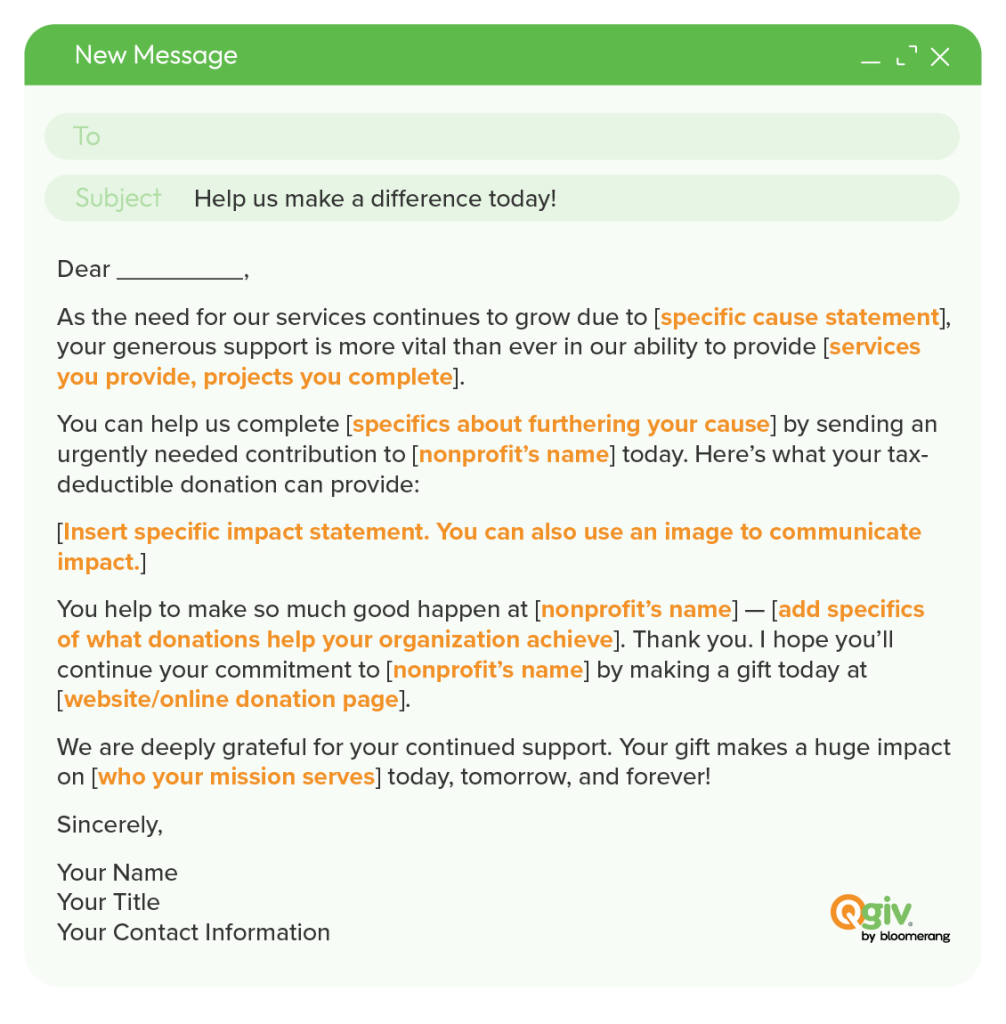
2. Event donation request email
Events allow you to connect with community members face-to-face and raise funds simultaneously. Instead of requesting donations directly, invite supporters to events where ticket funds will go toward your cause. Additionally, you may let donors know that you’ll be collecting extra contributions at the event to boost revenue further.
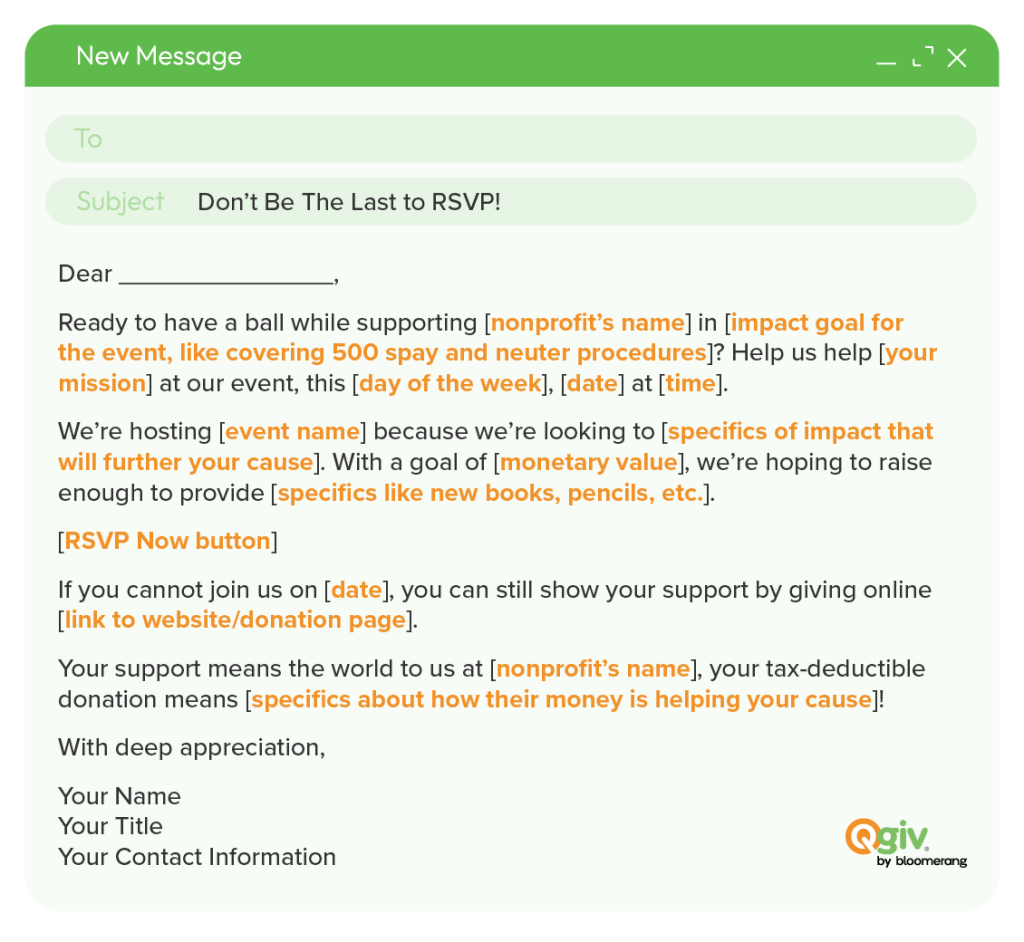
3. Impact-focused donation request email
Donors want to know that you’re using their funds responsibly to further your mission. By emphasizing impact in your donation request email, you can assure donors that you’re putting their hard-earned money to good use. Check out how the example below provides space for nonprofits to fill in what different donation amounts allow them to accomplish:
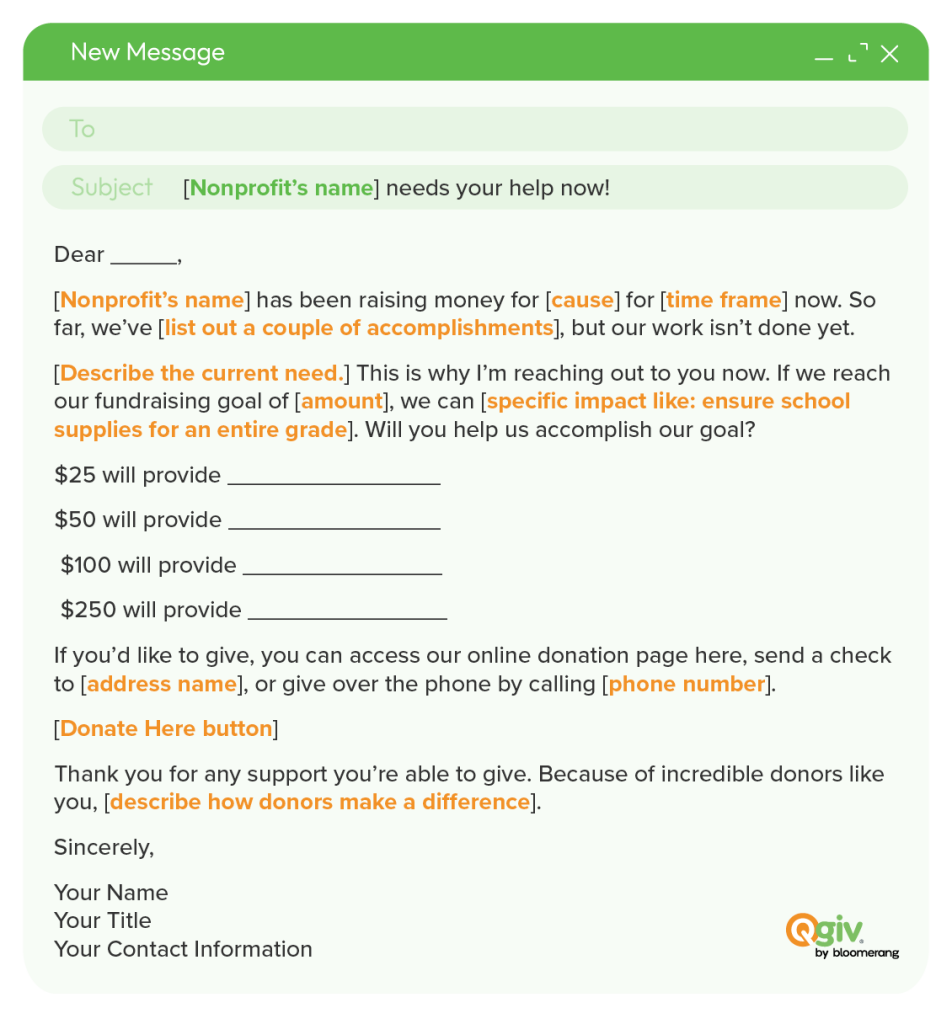
4. Crisis donation request email
Sometimes, an urgent appeal is necessary, and email is an efficient way to reach your supporters. Whether you’re dealing with an economic shift, political conflict, health crisis, or anything in between, acknowledge how current circumstances impact your donors and community and emphasize how much you’d appreciate their immediate support.

5. Campaign launch donation request email
Stir up excitement for a new campaign with a donation request email. Let donors know what your campaign will fund and how they can show their support. Keep your tone energetic and uplifting to encourage donors to get involved and spearhead this new fundraising effort.
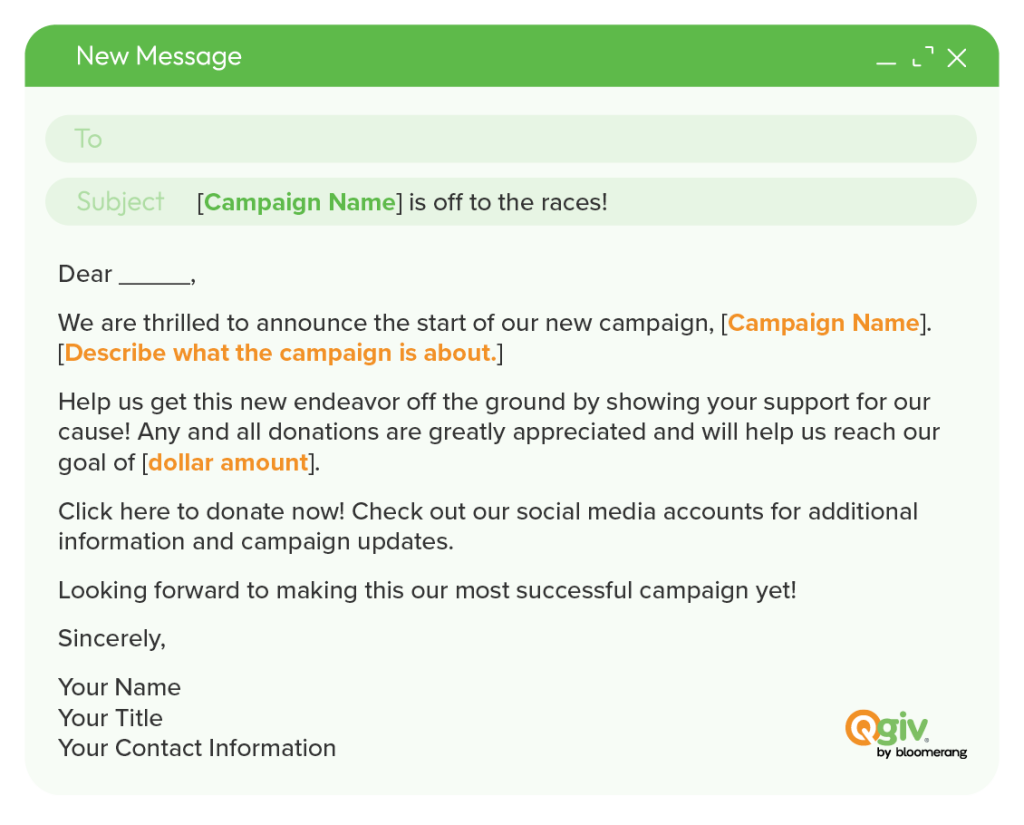
6. Recurring giving donation request email
In 2024, revenue from monthly giving increased by 5% and accounted for 31% of all online revenue. Recurring giving is on the rise and allows individuals to make an even larger impact on your cause. Not to mention, your nonprofit receives more steady revenue, too! Promote this win-win type of giving with the right donation request email.
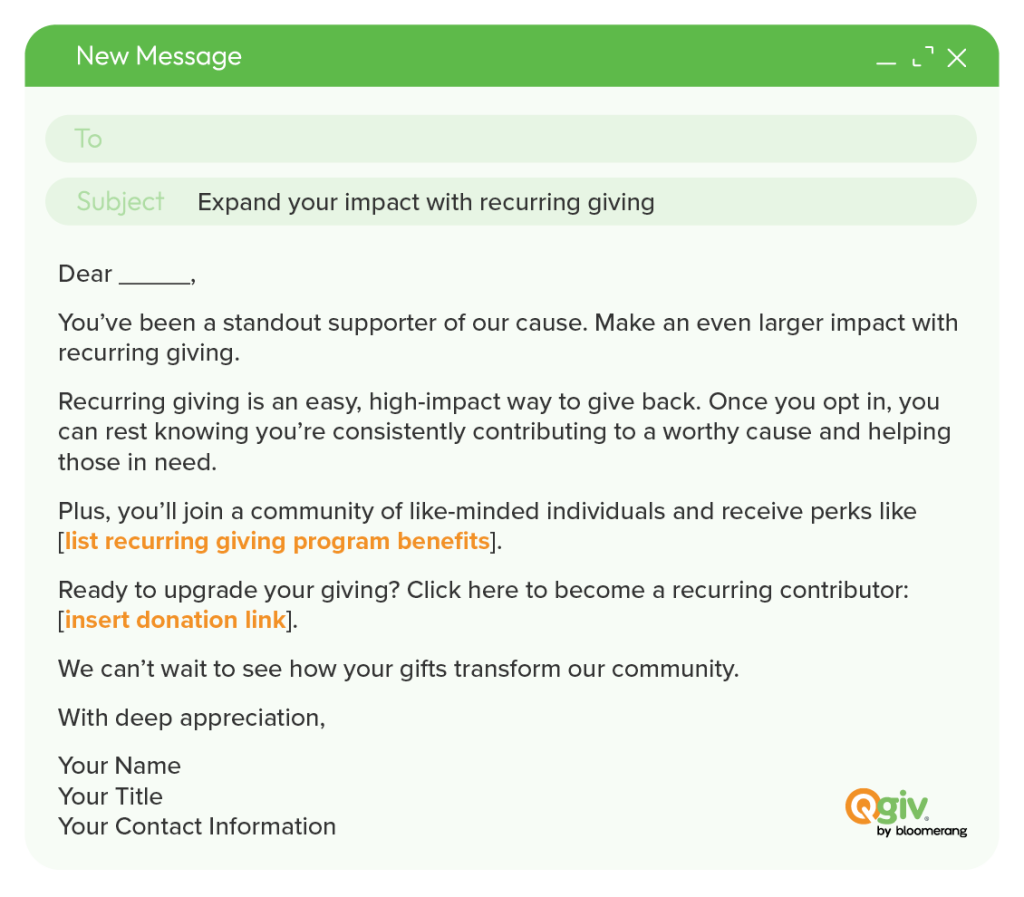
7. Year-end donation request email
Did you know that nonprofits received 40% of their 2024 online revenue in December? Year-end inspires donors’ generosity and puts them in the giving spirit. Take advantage of this giving-heavy time with donation request emails that push donors to contribute.
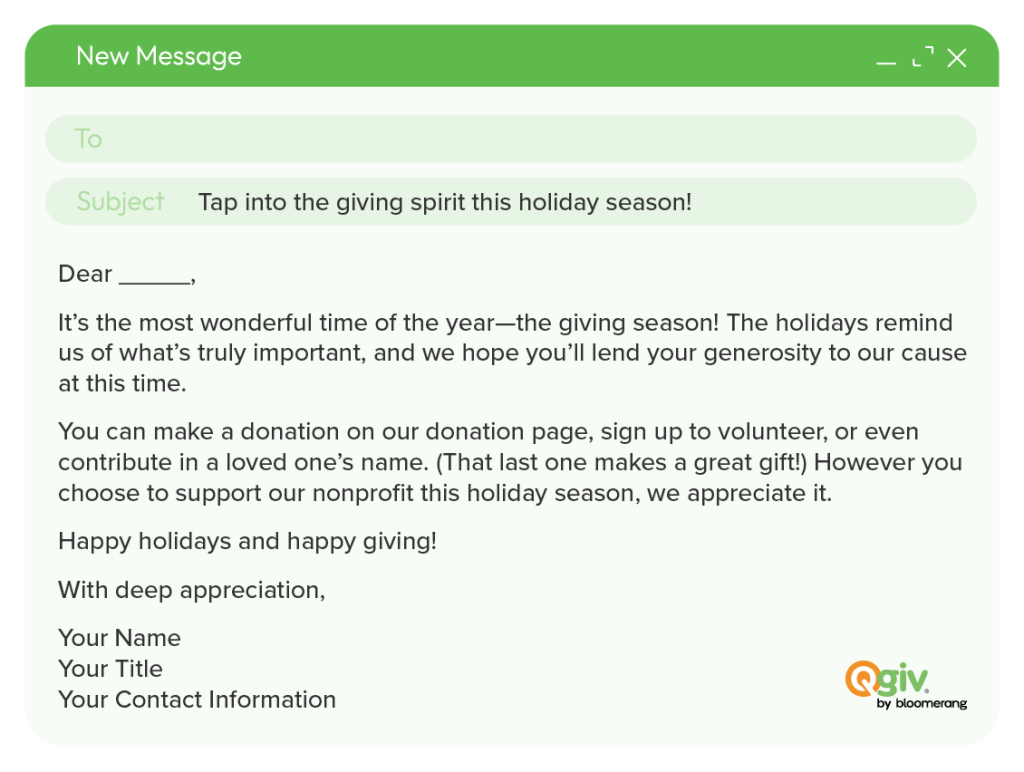
Final thoughts
Email is a cost-effective way to stay in touch with donors, ask for donations, and keep them updated on your current and future projects. When you incorporate fundraising appeals with other kinds of emails, you create a more well-rounded strategy that makes donors feel like part of your community.
Additional resources
For more information on raising money, check out these resources:
- Create an Email Welcome Series for Donors [With Templates]. Develop an effective welcome series for donors so they keep learning about and supporting your organization.
- 8 Online Donation Form Best Practices. Looking to raise more funds for your organization? Here are eight things you can do to improve your online donation form today!
- Nonprofit Fundraising: How to Run an Effective Campaign. If you’re searching for a full, comprehensive guide to fundraising, look no further! Here’s everything you need to know.
- 9 Tips for Asking for Donations. Asking for donations can be a daunting task. These tips will steer you in the right direction!


